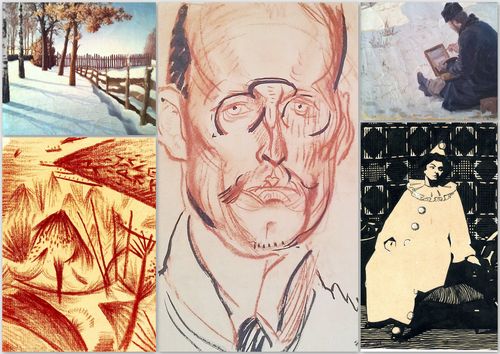A “different” Bohomazov
Audiences were shown, for the first time in 30 years, archival collection No. 360: the early works and personal documents of Oleksandr Bohomazov, a well-known cubo-futurist, the “Ukrainian Picasso”
A unique exposition was displayed at the exhibition hall of the Central State Archive-cum-Museum of Literature and Art of Ukraine. It was an exclusive opportunity for the general public to see the true originals, not copies, made by Oleksandr Bohomazov, a national avant-garde guru. The exhibit features oil paintings, watercolors, drawings, sketches, linocuts, pages of the theoretical treatise Painting: Elements, as well as poems, photographs, and the master’s personal correspondence.
Oleksandr Bohomazov is an artist in and a theoretician of Ukrainian and Russian avant-garde art. Experts distinguish the two best-known periods in his oeuvre: cubo-futurism (1913-17) and spectralism (1920-30). He took part, together with O. Exter, D. Burliuk, and M. Larionov, in the exhibit “Link,” organized by the cubo-futurist society Ring in 1913, and wrote a theoretical treatise, Painting: Elements, in 1914, which combined the master’s independent creative search and longtime artistic practice.
The post-revolutionary years laid the groundwork for the artist’s intense activities. In 1918 he delivers a report, “The Main Goals of the Development of Painting Art in Ukraine,” at a Ukrainian artists’ congress. In 1919 through 1920 Bohomazov is the acting first secretary of the Kyiv Artists Trade Union, chairs the art education section at the All-Ukrainian Art Committee. As a practitioner and theoretician, he made a major contribution to the development of national art. In 1922-30, Bohomazov was a professor of easel painting at the Kyiv Institute of Plastic Arts (now National Academy of Fine Arts and Architecture, where he taught artistic subjects at the teacher-training and painting faculties.
The exhibit allows one to discover new facets of the artist’s oeuvre, which are totally unknown to the admirers of his talent and are usually open to a narrow circle of specialists who have access to archives. “The Central State Archive bought the master’s works and biographical documents in the 1970s from his wife Wanda,” says Oksana Oliinyk, a senior research associate at the Central Archive-cum-Museum of Literature and Art. “We opened our collection No. 360 to show the spectator an almost ‘unknown’ Bohomazov of 1902-06, when he went to an art school. Displayed here are the refined graphics, colored and black-and-white lithographs, and draft sketches. There are also some easy-to-recognize and quite well-known works, such as Electrician, Hay Market, and a few self-portraits. Besides, there were different attitudes to Bohomazov’s heritage – his drawings could be bought for a song at Irpen’s flea-markets. Today, his works are being auctioned off at sky-high prices. But it also happens in the art world that fakes are passed off as Bohomazov’s works.”
The artist was in fact forgotten after his death, and later-time research brought back the maestro’s heritage to us in a true splendor. Credit for this should be given to art historians who devoted themselves to the careful study of his paining and theoretical heritage and archives. Olena Koshuba-Volvach, an art consultant at the archive-cum-museum, has written a monograph, Oleksandr Bohomazov: a Self-Portrait, which was published by Rodovid. Among those invited to the exhibit opening was Dmytro Gorbachov, a Ukrainian avant-garde expert, art historian, author and editor of the album Ukrainian Avant-garde, 1910-30.
Undoubtedly, the earlier items reveal a “different” Bohomazov who penetratingly studies nature at plein air sessions, paints the portraits of his colleagues, and presented us with a number of his self-portraits that belong to different periods. To enable the spectator to take a closer look at the artist, the archive also presented the pictures of him. A good-looking and intelligent face, the high brow of a theoretician, and an unchangeable pince-nez, – this is the Bohomazov that emerges before us. We can see the same, albeit very haggard, face on a late self-portrait – it is the inevitable and sad result of a longtime battle against tuberculosis that claimed the master’s life in 1930.
The wide range of items from Collection No. 360 can really broaden our vision of the artist – he becomes closer and livelier, especially when you look into his neat handwriting in his personal correspondence. As is known, when Bohomazov was a student, he met his future wife Wanda Monastyrska, a beautiful artist. For about five years, he wrote her wonderful letters about art, beauty, wisdom, which testifies to the master’s inner refinery, intellect, and philosophical ego. Also here, on the writing pad’s pages, are tentative drawings and sketches, as well as his famous parables.
You can see on one of the stands a replica of the cover of his theoretical work Painting: Elements (1914). The artist presents here his vision of interconnection between the object, the artist, the picture, and the spectator, and studies in detail the structural elements of a picture: the basic geometrical figures, color, and rhythm. Unfortunately, this treatise was not published in the artist’s lifetime.
The exhibit makes a fresh and bright impression on the audience – Bohomazov’s academic realistic portraits and landscapes, black-India-ink modern style graphics, and sad melancholic landscapes in the spirit of Ciurlionis. How difficult it is to imagine the caliber of a future master of cubo-futurism behind these works! Oil and watercolor landscapes, portraits, linocuts, pen and pencil drawings are interesting, above all, in that they describe the making of an artist called “Ukrainian Picasso.”
Tetiana Popova, a direct descendant of the artist, who visited the exhibit’s opening and made available some of his personal belongings, a painter’s case and the pince-nez, has granted an exclusive interview to Den, in which she spoke about Bohomazov’s oeuvre and private life and his favorite nooks in Kyiv. Read the interview in one of the upcoming issues.
Olena Shapiro is an art historian






